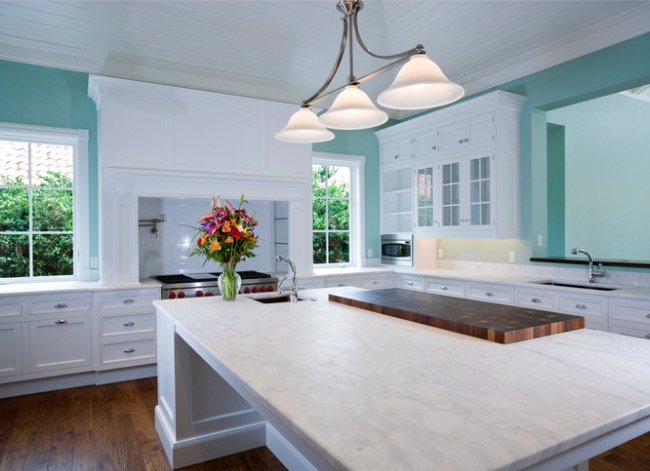We may earn revenue from the products available on this page and participate in affiliate programs. Learn More ›
Q: My kitchen doesn’t get much natural light, and our current light fixtures don’t provide adequate illumination for the overall space. What kitchen lighting design would you recommend?
A: A well-lit kitchen is a must given the room’s many uses as a social place, transit zone, food prep and cooking hub, and display area for decor. But beyond improving the overall visibility of the space, proper lighting makes it quicker and easier to stow or retrieve items in and under cabinets high or low, allows you to slice and dice with greater safety and precision, and can even make a kitchen look and feel larger.
While many homeowners cite a lack of natural light as the culprit behind their dim kitchen, artificial lighting of the wrong type or in the wrong location can add to the problem. When revamping lighting design, it’s smart to consider everything from function and fixture to the type of light bulbs you use. Ahead, find solutions to common kitchen lighting challenges to ensure the best kitchen lighting for all your needs.
RELATED: 25 Illuminating Lighting Ideas for a Beautiful Kitchen
Base your kitchen lighting design on three layers of lighting.
Your kitchen lights should ideally feature fixtures that fall in the following categories:
- Ambient lighting is soft overhead light that illuminates the floor and walls so you can easily enter, exit, and navigate the kitchen.
- Task lighting is brighter to illuminate countertops, islands, sinks, and other work areas for increased precision during food prep, cooking, and cleaning.
- Accent lighting, in between ambient and task lighting in brightness, highlights architectural features or decor in the kitchen, such as a coffered ceiling or a collection of fine china.
A layered approach incorporating all three types brings the right level of lighting for the various uses of a kitchen. It also helps minimize shadows, which often result from the exclusive use of overhead lighting, and glare, which can stem from only using bright task lighting.
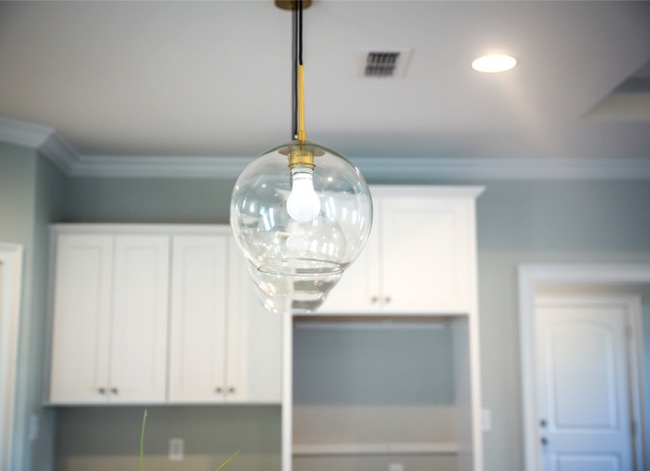
Buy kitchen ceiling light fixtures suited for each layer.
Look for the best fixtures in each of the three lighting categories:
- Ambient light fixtures in the kitchen include recessed lights mounted inside shallow openings in the ceiling, flush-mount or semi-flush-mount fixtures that affix to the ceiling with a small or large gap between the fixture and ceiling, respectively, and chandeliers or lanterns that hang from the ceiling by a chain.
- Task light fixtures include pendant lights that hang from the ceiling and multi-bulb LED strips or LED tape that mounts or sticks on or inside your kitchen cabinets, pantry, or drawers. Under-cabinet lighting is ideal for illuminating countertops
- Accent light fixtures include cove lights that are built into the ceiling and puck lights—round, low-profile lights that mount on or inside cabinets.
RELATED: The Best Online Lighting Stores, Vetted
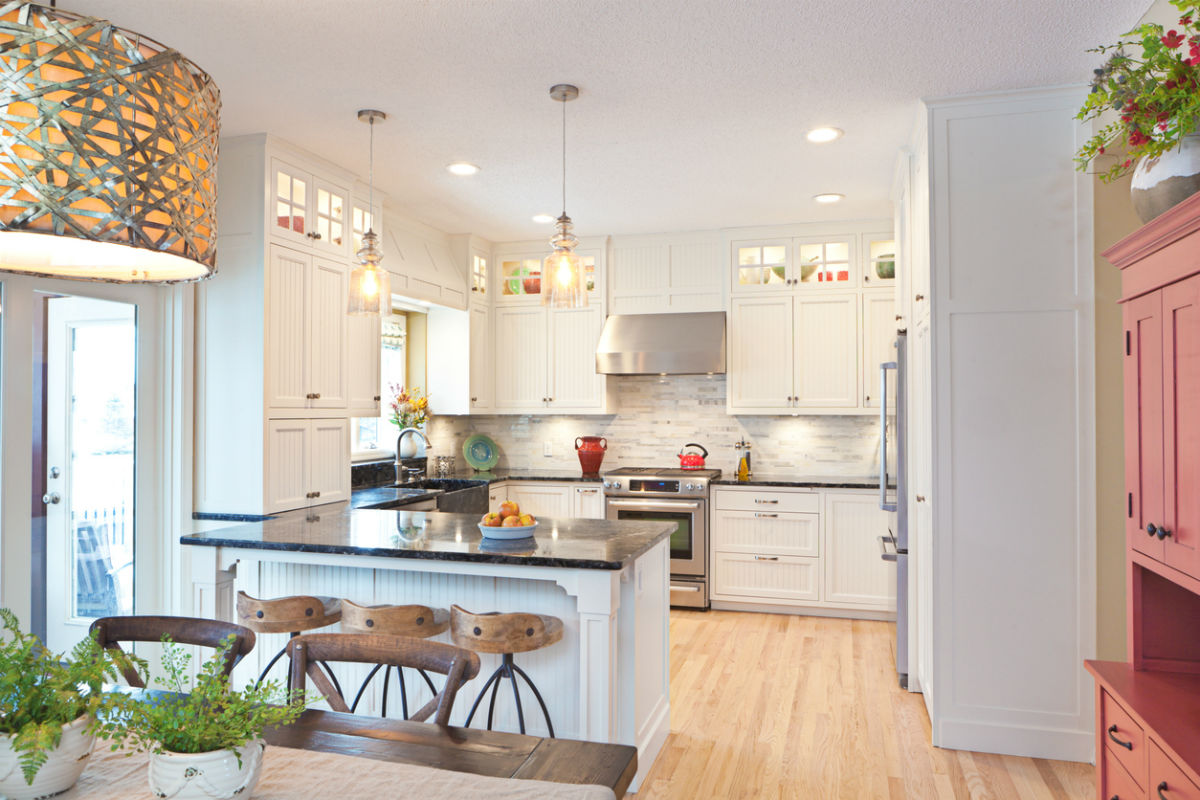
Position fixtures based on function and type.
Ambient light fixtures should direct light evenly across the kitchen floor, so position them as follows:
- When installing a single semi-flush-mount or flush-mount fixture, chandelier, or lantern, position it directly above the island, or at the center of the ceiling if you don’t have an island.
- When installing recessed lights, leave a distance between the lights equaling half the height of the ceiling (e.g., space lights 5 feet apart in a kitchen with a 10-foot ceiling). To avoid casting shadows on countertops, try to position recessed lights above countertops so they are set a few inches back from the front edge of the countertops.
Task lighting should cast light down onto a work surface, so position them as follows:
- Pendant lights are ideally placed directly above sinks, standalone chopping stations, dining tables, and other hubs of activity. But you also want to avoid placing them directly above appliances with their own built-in lighting, such as stove ranges or refrigerators. To minimize glare while you work, mount so that the pendant is no closer than 2 ½ feet from the surface it’s lighting.
- LED light strips or tape should be placed on the underside of upper cabinets to cast a spotlight on food and drinks on countertops. Placing them inside drawers, behind cabinet or pantry doors, or on the underside of base cabinets can also afford easier storage and retrieval of utensils, food, pots and pans, or cleaning supplies kept inside. Mount these lights 1 to 3 inches from the front of the cabinet to reduce glare.
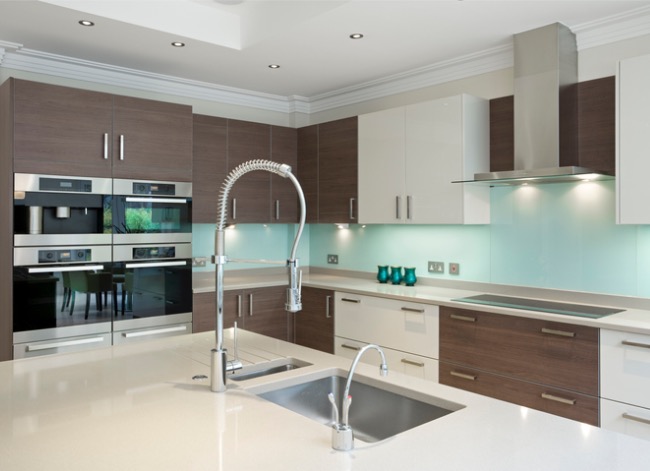
Accent lighting should highlight the details or decor you want to show off, so position them as follows:
- Install cove lights in the ledges of a ceiling to play up decorative ceiling tiles.
- Place puck lights on the underside of upper cabinets to showcase vases or other countertop decor, or on the roof of a cabinet shelf, 1 to 2 inches from the back of the shelf, to elegantly backlight tea sets and other showpieces.
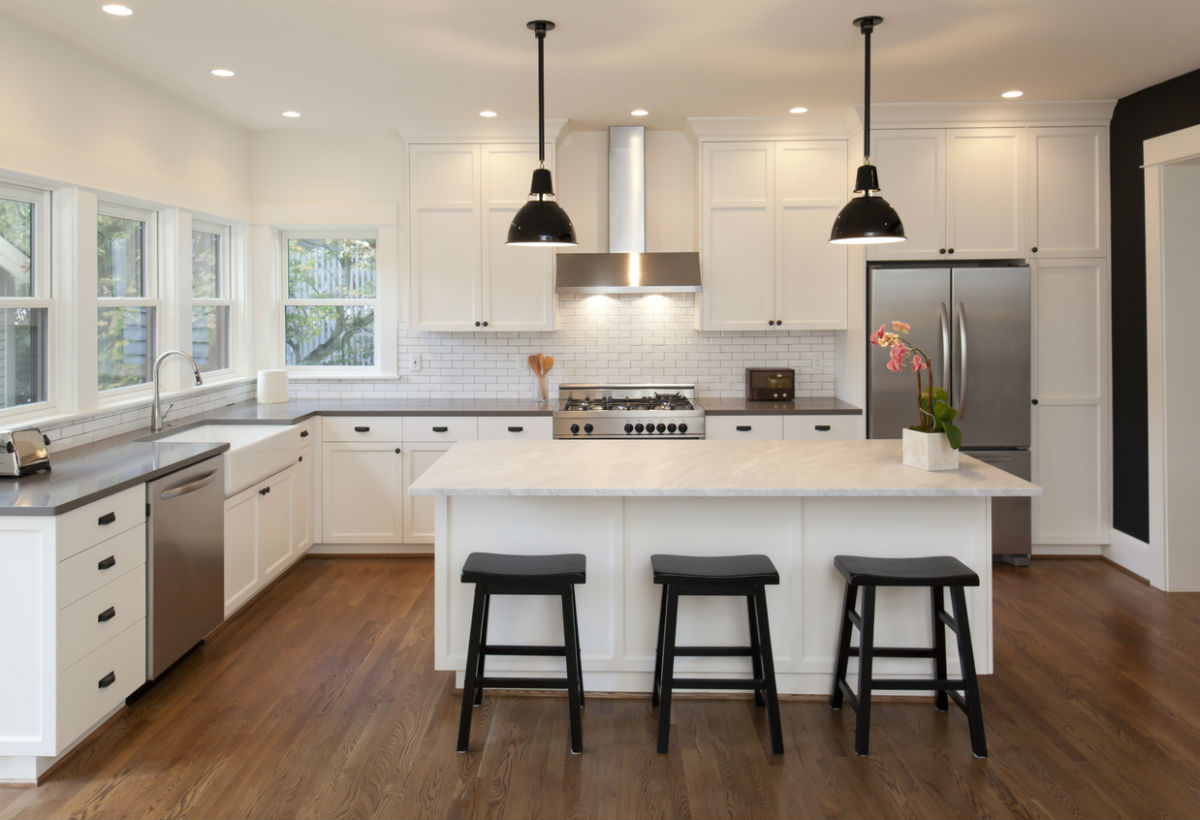
Use light housings to diffuse light over glossy kitchen surfaces.
Certain LED light fixtures, such as LED strips, cast a beam of light onto a surface that is brightest and most concentrated at the center of the beam and less bright on the edges. This is suitable for countertops made of butcher block, stone, or another material with a flat or matte finish. But with marble, granite, or similarly glossy materials, the center of the beam can produce a distracting glare even when placed a few feet away from it. To avoid this, place LED light strips inside light housings, which are aluminum channels with frosted covers that help diffuse bright light and minimize glare on shiny kitchen surfaces.
Choose bulbs that emit ideal color temperature.
Incandescent, compact fluorescent light (CFL), and LED light bulbs for the kitchen come in one of three color temperatures that describe the color characteristics of the light the bulb emits. There’s Soft White (2700K to 3000 Kelvins (K)), Cool White/Bright White (3500K to 4100K), and Daylight (5000K to 6500K). The higher the bulb temperature, the cooler (i.e., bluer) the light it emits; the lower the temperature, the warmer (i.e., more amber) the light. Choose the color temperature best suited for the function of the fixture:
-
Ambient and task light fixtures: Opt for bulbs with a color temperature of 3500K to 4100K to ensure that floors and work surfaces are lit with a neutral, true white light.
-
Accent light fixtures: Choose a temperature of 2700K to 3000K to backlight showpieces with warmer light, or a temperature of 3500K to 4100K to cast sharper white light on muted architectural details or decor you want to play up.
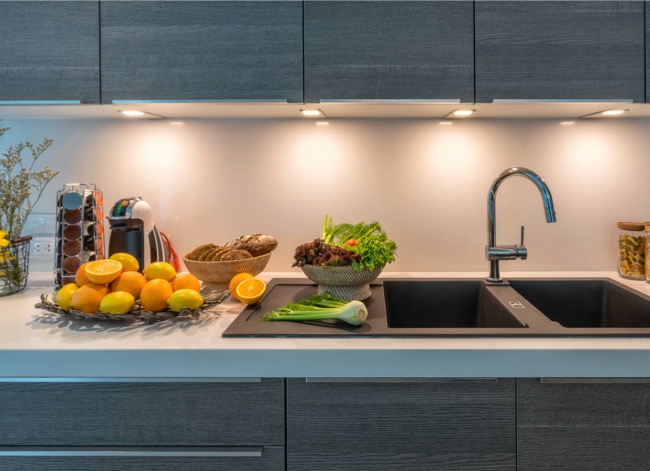
Incorporate natural light sources.
Remodeling your kitchen to include a natural ambient light source such as a skylight or one or more windows can lend extra warmth to the room and fill any gaps in the light coverage of your artificial light fixtures. Even in a packed kitchen, there will often be vacant spots where you can install a window, including:
- A small window set in the middle of a backsplash.
- Tall and narrow windows placed in a gap on the wall between upper cabinets.
- Clerestory windows, which are short and wide windows that sit above the eye level, usually located along the top of a wall.
- Porthole windows, which are small, round windows placed high on a wall.
- Adding a pane of glass to a door.
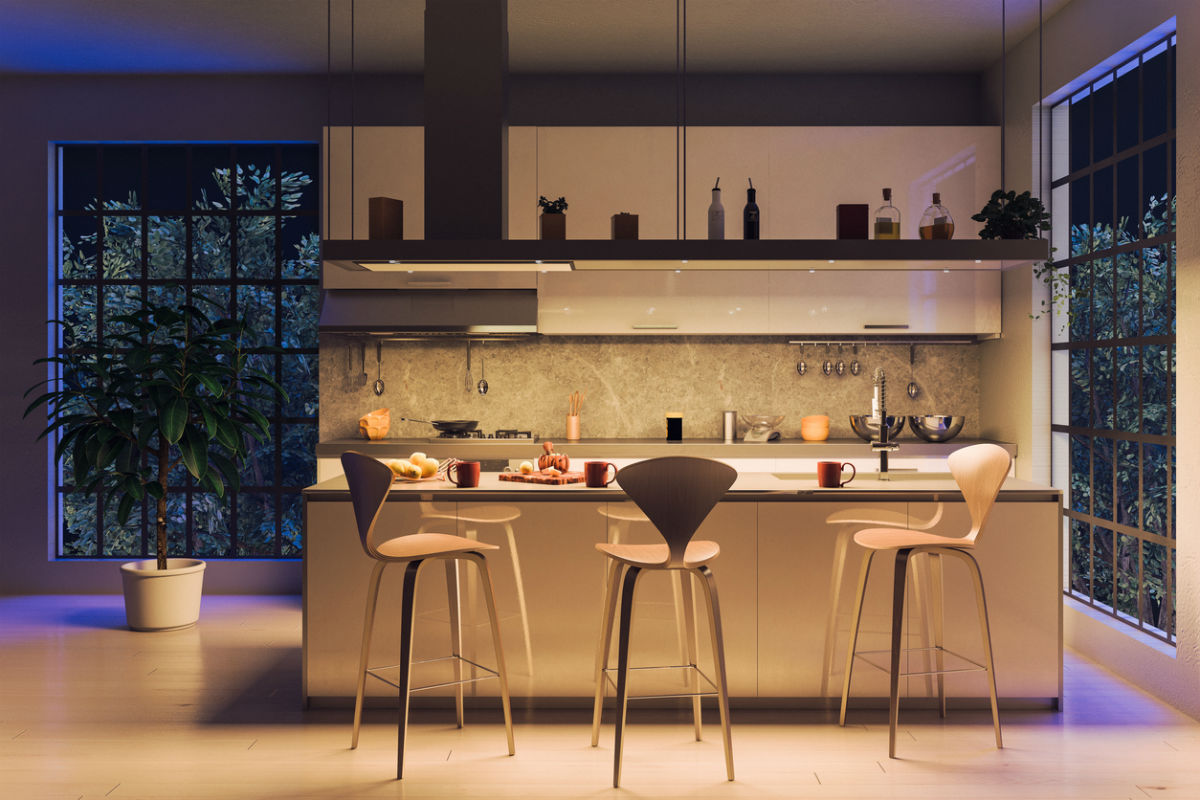
Final Thoughts
Providing effective and attractive kitchen lighting is simply a matter of layering appropriate lighting types into your kitchen lighting design. Plan out and install the right mix of ambient, task, and accent lighting and your space will be well-lit and safe. With the right kitchen ceiling lights, your beautiful new space will be ready for festive gatherings with family and friends.
FAQs About Kitchen Lighting Design
Overhauling the lighting in your kitchen should be done with considerable attention to detail, and you certainly want to have all your questions answered before you begin. Check out these FAQs to ensure you’re fully armed with all the information you need.
Q. What are the best lights for kitchens?
For safety and functionality, you’ll want lights that provide ambient and task light. Depending on your setup, you may also need accent lighting to highlight special features in your space. Be sure to find lights that are properly rated for the wet, potentially grimy environment of a kitchen.
Q. How do I choose a kitchen light fixture?
First determine the functionality of the lighting you need. Then consider the decor of your home and which style of light fixture is the best match. Pricing, too, may be a factor, as there is a wide range of prices associated with lighting and you’ll want to select kitchen light fixtures that align with your budget.
Q. How do I choose a kitchen chandelier?
Choose a fixture that emits adequate lighting for your environment, and select one that complements your design style. You’ll likely have to peruse lots of web stores to find the kitchen chandelier that’s just perfect for your space, but the effort is worth it.

